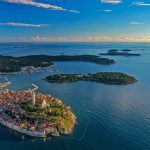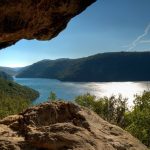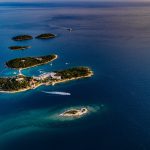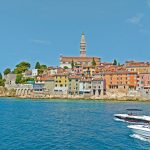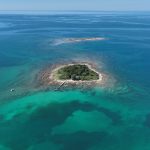1. Rovinj Old Town
Rovinj was actually an island before a land reclamation project in 1763 by the Venetians. What you’ll see in the old town is a medieval tangle of tight streets and alleys that pass under archways and twist up stairways worn by centuries of footfalls.The square campanile of this baroque church dominate Rovinj’s skyline and closely resembles St. Mark’s in Venice. So it’s no surprise that the 17th-century St. Euphemia was built by the Venetians, who were in control of Rovinj throughout this period. To get the lie of the land you can make your way up the campanile, which is 61 metres-high and even offers views of the Alps to the north on a clear day.
RECOMMENDATION: Book a free city tour and learn a lot more about the history of the city.
More info: Razgledi grada | (rovinj-tourism.com)
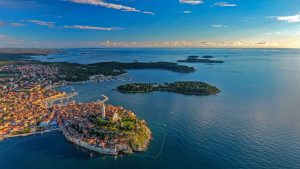
2. Park Punta Corrente
The boot-shaped peninsula a short way south of Rovinj is a relaxing natural park. Punta Corrente (Golden Cape) was the vision of the 19th-century Austrian industrialist Johann Georg von Hütterott who purchased this land and allowed its nature to flourish. Now it’s nothing short of an idyll; a beautiful swathe of softwood forest, where cedars, Douglas firs, cypresses and Aleppo pines planted more than 100 years ago are thriving. Come here to saunter along the trails, relax on the grassy areas or unwind by the little rocky coves along the coast.
RECOMMENDATION: Biking through the park, rock climbing, running, easy walking or swimming and relaxing on the beach.
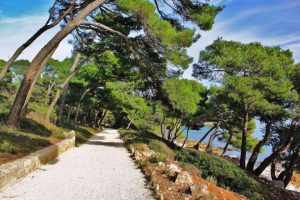
3. Rovinj Sunset Tour
Rovinj is considered as a town with one of the most romantic sunsets on Adriatic sea. The rhapsody of colours from many shades of orange to pink will create the magical scenery which you will not forget easily. Witness the spectacle of the glowing sun linger over the horizon and the fascinating moment of slipping into the sea. *If lucky, enjoy the sea dance of wild dolphins.
RECOMMENDATION: BOOK ACTIVITIES – Hedonistria
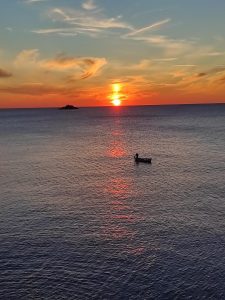
4. Brijuni Nacional park
The Maker intended to shape a part of the Earth to the image of Heaven. That is how Istria came into being, like a garden covered with magnificent trees and vast meadows, washed by the deep blue sea, appealing people to a happier life. But the jealous devil destroyed his work by tearing the bag in which the angel was carrying the unused stones. Thousands of rocks scattered around the Istrian land making it a land of contrasts, gentle and rough, fertile and barren, sunny and cloudy. The desolated angels gathered the pieces of Heaven remaining among the scattered rocks and protected them by the sea waves and created Brijuni.
RECOMMENDATION: Choose the excursion type | NP Brijuni Webshop (np-brijuni.hr)

5. Lim Fjord
You can reach this strange and beautiful natural wonder by road or by tour boat from Rovinj’s port. It is described as both a fjord and a canal, but really it’s a 10 kilometre-long river canyon guarded by steep wooded mountainsides that soar to 100 metres. What really makes this scene and gives it the appearance of a fjord is the width of the river, up to 600 metres in places. On land you can hike or bike through the mix of deciduous and coniferous forest and stop by at the restaurant at the mouth of the canyon. Here they serve seafood such as oysters and mussels farmed in these waters.
RECOMMENDATION: Oysters directly from the sea and glasses of wine are simply a must try.

6. Dvigrad
Take a 20-minute trip through the Istrian countryside to see the ruins of a medieval town that was abandoned in the 1700s during a plague epidemic, never to be repopulated. You can see the castle’s crenellated tower from the Lim Fjord and on a visit you’ll be free to nose around these evocative ruins, including the town gate, walls, some 200 houses and the sagging ruins of the St. Sophia church. The entire site is being restored and over time more of this eerie old town is taking shape.
RECOMMENDATION: Visit the park of the protected Istrian Boškarin in Kanfanar.
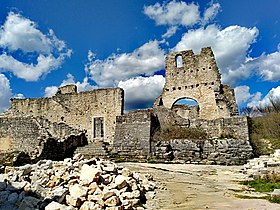
7. Motovun Truffle city
The first mention of the town of Motovun called Montona (Celtic origin, meaning - Town in the hill) is found in the document of the Rižana Assembly manuscript from 804 (Placitum of Riziano), and after a century of German rule and the Patriarch of Aquileia Motovun in 1278 asked Venice to accept it under his rule and under which he remained until 1797.
RECOMMENDATION: Truffle hunting with a fantastic lunch, Truffles - Gold from Istria (tartufi-istra.com)
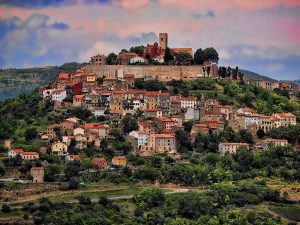
8. Arena Pula
The most famous and significant monument, the building from which every tour of the city begins and ends - the Pula Arena - a building where gladiator fights were held. It was built in the 1st century, during the reign of Emperor Vespasian, at the same time as the largest and most famous building of its kind - the Colosseum in Rome. It is elliptical in shape, with a main axis 130 meters long and a shorter axis 100 meters long. In the middle is a flat area - the arena, and the spectators sat on the stone steps or stood in the gallery. It is believed that the Arena could accommodate 20,000 spectators. It was built from local limestone. In the Middle Ages, the Arena was used for knightly tournaments and fairs. Today it is used for summer events - Film Festival, Opera Season, Equestrian Festival, concerts... when it can accommodate around 5,000 spectators.
RECOMMENDATION: Events you shouldnt miss - Events - Turistička zajednica grada Pule (pulainfo.hr)
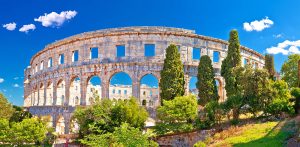
9. Grožnjan the city of artists
An Istrian stone town built by giants and brought to life by artists. According to one of the most famous Croatian legends, long before people settled in Istria, giants lived there. They built small towns that still stand today on the Istrian hills, and it is said that they were so big that they added tools from one hill to another, and that's how Grožnjan was born. The biggest giant, Dragonja, plowed a furrow from Ćićarija towards the sea, and the present-day Mirna river flowed through it, and the locals say that Dragonja's son - Gorazd - still lives in the Istrian forests.
RECOMMENDATION: Visits local restaurants
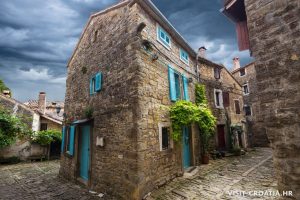
10. Vrsar the city of Casanova
The Romanesque tower belongs to the Vrsar fortification system and is one of the two preserved ones. It was built in the Middle Ages in the Romanesque style, and was renovated in 2017. After the renovation, it is intended to serve as Casanova's "Shelter" and a modern information and multimedia center documenting Mr. Casanova's stay in Vrsar in the 1840s. century.
RECOMMENDATION: Casanova Tour Vrsar (casanovavrsar.com)



